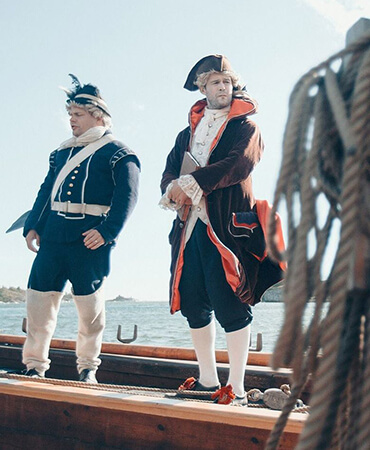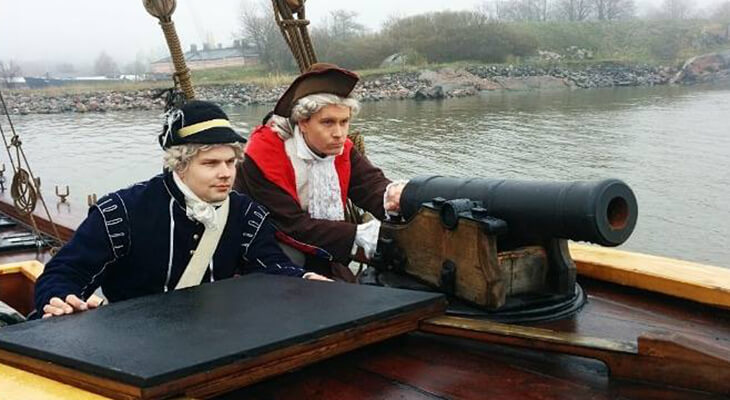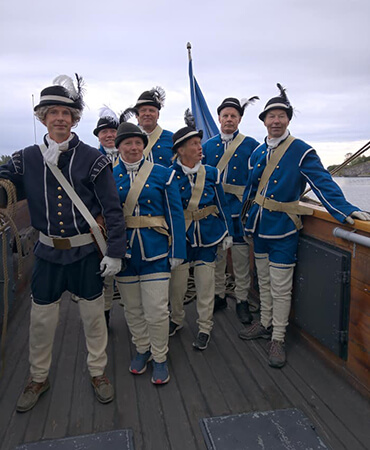Crew of Archipelago Navy
 Viapori Commandant Augustin Ehrensvärd divided the crew of the archipelago fleet under the army into two groups: his own permanent crew and borrowed crew. The permanent crew was maintained during both war and peace and was in charge of the archipelago fleet. The borrowed crew, in turn, was ordered during the war to reinforce permanent forces. The archipelago’s own crew consisted of stern sailors, recruited naval artillery troops, men wrapped in rolls, suitcase recruiters recruited from merchant ships, ship boys, officers, pilots, and carpenters. Borrowed, the so-called. the temporary crew, in turn, consisted of Army soldiers, who on ships in the archipelago navy were mainly responsible for rowing. Infantry soldiers were also needed in the landings. The need for crew varied greatly at different times. This was due to, among other things, wars, the growth of the archipelago fleet and new types of vessels requiring less crew.
Viapori Commandant Augustin Ehrensvärd divided the crew of the archipelago fleet under the army into two groups: his own permanent crew and borrowed crew. The permanent crew was maintained during both war and peace and was in charge of the archipelago fleet. The borrowed crew, in turn, was ordered during the war to reinforce permanent forces. The archipelago’s own crew consisted of stern sailors, recruited naval artillery troops, men wrapped in rolls, suitcase recruiters recruited from merchant ships, ship boys, officers, pilots, and carpenters. Borrowed, the so-called. the temporary crew, in turn, consisted of Army soldiers, who on ships in the archipelago navy were mainly responsible for rowing. Infantry soldiers were also needed in the landings. The need for crew varied greatly at different times. This was due to, among other things, wars, the growth of the archipelago fleet and new types of vessels requiring less crew.
Cannon Sloop Diana Crew
Army soldiers made up more than half of the crew of the archipelago navy during the War of Gustav III. Most of the men in the infantry and cavalry regiments were inexperienced sailors, which is why they were used mainly as rowers. In the Battle of Ruotsinsalmi in 1790, about 40 army soldiers served in one cannon magnifying glass, taking care of rowing and landing. They could also help with cannons, nikhakas and rudders. In addition, about every other sloop had an army officer. The entire Crew crew, including the permanent crew, consisted of about 50-60 men.
Conditions in the artillery loops were cramped; The 2.1-meter-wide benches were meant to seat four rowers. There was a meager 0.74 meters between the benches. Crew members were able to store their personal belongings in a space between the benches and the sides, which was divided into separate laurels. Officers used stern coffins and their decks as storage berths to store their belongings. There was no special sleeping space for the crew in the open slups. Overnight stays took place on land in tents or peasantry, sometimes even on rowing benches. Crew food in the artillery magnifiers was handled from special cooking boats or prepared on the islands. One cooking boat was always in charge of 4-5 sloups of food. The meals consisted mainly of porridge, peas, dried meat, salted lacquer or dried fish, and hard rye bread. Sometimes fresh food was also obtained from coastal houses. Vinegar was mixed with the drinking water, which improved the quality of the water. Tobacco and smoking liquor obtained in daily doses were general remedies for various ailments.

In the open sloops, the crew on long rowing trips were completely at the mercy of the wind and rain and once wet equipment could not be easily dried. In cramped and humid conditions, diseases spread quickly from one rower to another. The spread of diseases was difficult to prevent due to poor hygiene. Sore throat and diarrhea were common diseases among snuff crews. The sick and those wounded in battle were transferred to special sick boats, from which they were transferred ashore as soon as possible to receive more treatment. There was no proper treatment in the countries either; the men may have had to lie on the bare floor and there were not enough shackles or supplies. Onshore hospitals, such as Viapori Hospital, were quickly filled with wounded and sick men.
Conscripts as artillery magnifying guns in the 1808-1809 war
At the beginning of the 19th century, the Swedish defense was based on a permanent army, mainly of Swedish soldiers. Due to the scarcity of troops, in the spring of 1808, Sweden’s top leadership decided to mobilize special troops based on universal military service in addition to these permanent troops. All the young people aged 18-25 were called to defend Sweden alongside the permanent troops. Later, the age was changed to cover only 19-25 year olds. The troops consisted of about 30,000 men, of whom an estimated 4,000 served in the Åland and Turku archipelagos as rowers, mainly in artillery magnifiers, but some also in larger calibers.

Conscripts received a few weeks of training. There were not enough rifles for everyone, nor did the men get uniforms, but had to settle for their own clothes. The departure from the homeland took place in June-July, so many had dressed very lightly. Conscripts were not equipped to be at sea until November. In the home regions, clothing collections were carried out for the benefit of freezing soldiers. At a higher level, uniforms were designed for soldiers, but the endless design of the details prevented the uniforms from being sent to soldiers suffering from the cold. The cause of many deaths was not only inadequate clothing and cold, but also illness. “Lantvärnsjukan,” which was a generic term for diseases contracted by soldiers, quickly spread to the civilian population as well. During the campaign, food supply was often awkward and the cooking boats had difficulty feeding the crews of all the artillery loupes. Disciplinary problems were also common in artillery magnifiers. Disobedience could even result in the death penalty, but these were often not enforced.
Nordman, Hans (ed.): Skärgårdsflottan, Falun 2000.
Malmqvist, Olle & Welander Larsson, Iréne: De oändligt förbannade sluparna – episoder från sjöstriderna mot Ryssland 1808-1809, Karlskrona 2008.
© 2013 Tykkisluuppi
